 |
SZACHY
Szachy, zadania szachowe i nie tylko
|
| Zobacz poprzedni temat :: Zobacz następny temat |
| Autor |
Wiadomość |
wladek
Dołączył: 14 Gru 2006
Posty: 49118
Przeczytał: 0 tematów
Pomógł: 3 razy
Ostrzeżeń: 0/5
Skąd: Polaniec
|
 Wysłany: Śro 8:01, 22 Sie 2012 Temat postu: Wysłany: Śro 8:01, 22 Sie 2012 Temat postu: |
|
|
=---
Trzychodowka z rozwiazaniem!
78 - P1031114
Autor : Samuel Loyd
Checkmate 1903
80 150 Schachkuriositäten 1910
348 Augsburger Allgemeine 1995
1. Preis
----------
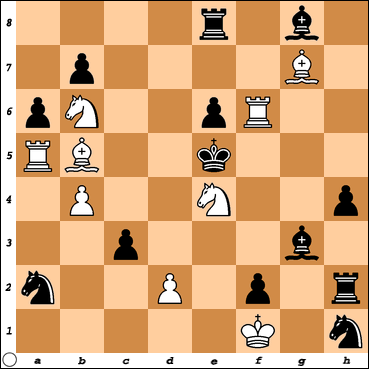
Mat w 3 posunieciach --- #3
Rozwiazanie
1. Ke2!! - f1=H!++
2. Ke3 -- Hxb5
3. d4 - mat
--------------
1. Ke2 - f1=H++
2. Ke3 - We2+
3. Gxe2 - mat --- diagram -- 2
1. Ke2 - f1=H! ++
2. Ke3 -- Hg1+
3. Wf2 - mat --- diagram -- 3
--------
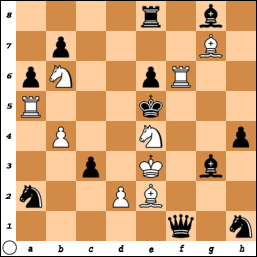 _3 _3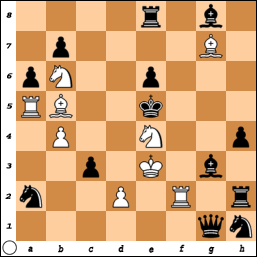
1.Ke2 -
f1=H+ - 2. Ke3 - We2+ - 3. Gxe2 mat --- 1.Ke2 - f1=H - 2. Ke3 - Hg1+ - 3. Wf2 mat
--
Na stronie jest wiecej zadan szachowych -- S. Loyd
[link widoczny dla zalogowanych]
--
Post został pochwalony 0 razy
|
|
| Powrót do góry |
|
 |
|
|
 |
| Zobacz poprzedni temat :: Zobacz następny temat |
| Autor |
Wiadomość |
wladek
Dołączył: 14 Gru 2006
Posty: 49118
Przeczytał: 0 tematów
Pomógł: 3 razy
Ostrzeżeń: 0/5
Skąd: Polaniec
|
 Wysłany: Sob 17:09, 01 Wrz 2012 Temat postu: Wysłany: Sob 17:09, 01 Wrz 2012 Temat postu: |
|
|
--
Poznaj zadania -- S. Loyda!
Autor : Samuel Loyd - 1856
-----------------
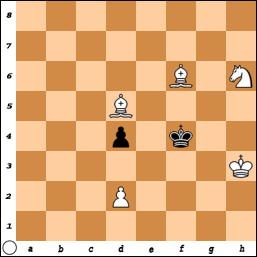 1___2 1___2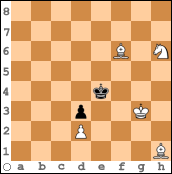
Biale matuja w 3 posunieciach -- #3 ---- --- wyzej siatka matowa
Zadanie -- 15-letniego -- S. LOYDA
------------
Program „Szachy w szkole” zyskał poparcie Parlamentu Europejskiego!
Niezmiernie miło nam poinformować, że Oświadczenie Pisemne 50/2011 dotyczące wprowadzenia programu "Szachy w szkole" w szkołach w Unii Europejskiej zostało podpisane przez 415 posłów do Parlamentu Europejskiego (potrzebne było 378 podpisów, czyli 50% + 1 z całkowitej liczby 754 Europosłów). Po zakończonej sesji Parlamentu Europejskiego, Europosłowie gratulowali prezydentowi Europejskiej Unii Szachowej, podkreślając, że zatwierdzenie programu jest wielkim sukcesem - zazwyczaj tylko 10-15% oświadczeń zyskuje wymaganą liczbę głosów.
Wszystkie działania promujące program "Szachy w szkole" odbywały się pod patronatem honorowym prof. Jerzego Buzka, poprzedniego prezydenta Parlamentu Europejskiego oraz Slavy Bineva, posła do Parlamentu Europejskiego z Bułgarii, który wspierał projekt i wprowadzenie Oświadczenia Pisemnego 50/2011.
Polski Związek Szachowy włączył się w kampanię promująca "Szachy w szkole", nawiązując kontakt ze wszystkimi polskimi Europosłami. Warto nadmienić, że polscy Europarlamentarzyści niemal w komplecie podpisali się pod wprowadzeniem programu "Szachy w szkole". Dziękujemy!
Informacja na stronie Europejskiej Unii Szachowej
------------------------
96 - P1054045
Autor : Waldemar Tura
Schach 1973 -- FIDE Album (1971-1973)
-------
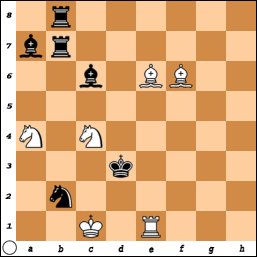
Mat w 2 posunieciach --
Rozwiązanie
1. Scb6! -- [2. Sc5, Sxb2#]
1. ... Gxb6 -- 2. Sxb2#
1. ... Wxb6 -- 2. Sc5#
1. ... Gxa4 -- 2. Gf5#
1. ... Sxa4 -- 2. Gc4#
1. ... Sc4 ---- 2. Gxc4 #
-----
Post został pochwalony 0 razy
|
|
| Powrót do góry |
|
 |
| Zobacz poprzedni temat :: Zobacz następny temat |
| Autor |
Wiadomość |
wladek
Dołączył: 14 Gru 2006
Posty: 49118
Przeczytał: 0 tematów
Pomógł: 3 razy
Ostrzeżeń: 0/5
Skąd: Polaniec
|
 Wysłany: Nie 20:52, 02 Wrz 2012 Temat postu: Wysłany: Nie 20:52, 02 Wrz 2012 Temat postu: |
|
|
----
SYCYLIJSKA
[link widoczny dla zalogowanych]
Modernes Sizilianisch – richtig gespielt
Książki po niemiecku (debiuty), Moje publikacje
28 lutego 2012 -- Jerzy Konikowski
W pracy trenerskiej polecałem moim podopiecznym stosowanie debiutów pasujących do ich stylu gry. Ale zanim to się wykrystalizowało w grze każdego młodego gracza, trzeba było coś wstępnie polecić, przygotować materiały, wyjaśnić strategię i taktykę danego otwarcia.
Sam wychodziłem – na bazie moich wieloletnich doświadczeń – z założenia, że najlepszym obiektem studiów dla młodych zawodników jest obrona sycylijska, która jest bardzo bogata w motywy strategiczno-taktyczne. Po jakimś czasie zawodnik jest już sam w stanie określić, co mu najbrdziej „leży” i co chciałby włączyć na stałe do swego repertuaru debiutowego.
Sama obrona sycylijska jest bogata w różne systemy i warianty. Moim zdaniem najbardziej wartościowe pod kątem różnorodności w motywy jest system smoczy i Najdorfa. W moim punkcie szkoleniowym w Essem przez wiele lat trenowałem z podopiecznymi „Najdorfa”. W ciągu kilku lat zebrał się materiał analityczno-informacyjny i na bazie tych doświadczeń powstała ta praca.
Jest to książka repertuarowa. Zalecam w niej zapoznanie się z systemem Najdorfa i to w całej jego rozciągłości. Czytelnik ma poznać możliwie wszystkie powstające warianty w tym systemie i jakie wynikają w nich plany strategiczno-taktyczne.
Po ruchach 1.e4 c5
--- 1. e4 -- c5__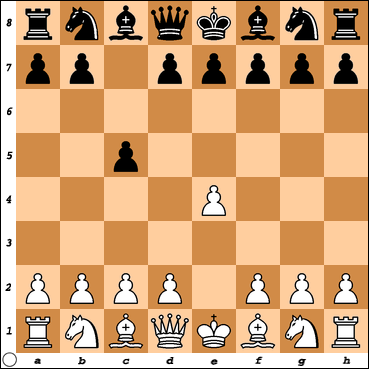
białe mogą też, oprócz 2. Sf3, grać 2. Sc3 (rozdział 1),
2. c3 (rozdział 2), 2. d4 (rozdział 3) i 2. f4 (rozdział 4).
2. Sf3 d6
-- 2. Sf3 -- d6 __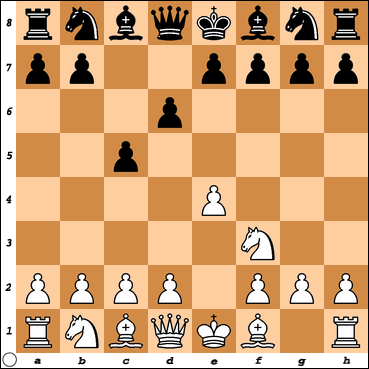
-----
3. d4
Wariant po 3. Gb5+ został omówiony w rozdziale 5.
3. ... cxd4 4. Sxd4
Możliwość 4. Hxd4 przedstawiłem w wprowadzeniu.
4. ... Sf6 5. Sc3 a6
---------
Diagram po 5 pos._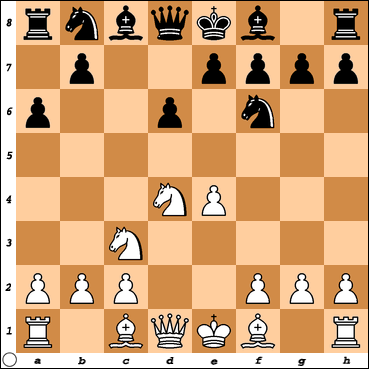
Pozycja po
5 posunieciach - 1. e4 c5 2. Sf3 d6 3. d4 cxd4 4. Sxd4 Sf6 5. Sc3 a6
--- 6. Gg5
6. f3 (rozdział 6)
6. Ge3 (rozdział 7)
6. f4 (rozdział 8]
6. g3 (rozdział 9)
6. Ge2 (rozdział 10)
6. Gc4 (rozdział 11)
Inne warianty po 6.h3, 6. a4, 6. Gd3 i 6. Wg1 zostały omówione w wprowadzeniu.
6. ... e6 7. f4
7. Gc4, 7. He2, 7. Hf3, 7. Hd3 i 7. Hd2 zostały przedstawione w wprowadzeniu.
Pozycja po 7. f4_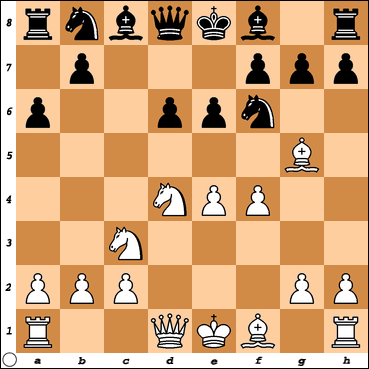
7. ... Ge7
7. ... Hb6 (rozdział 12)
7. ... b5 (rozdział 13)
7. ... Hc7 (rozdział 14)
7. ... Sbd7 (rozdział 15)
7. ... Sc6 (rozdział 16)
7. ... h6 (rozdział 17)
8. Hf3 Hc7 9. 0-0-0 Sbd7 10. g4
10. Hg3 i 10. Ge2 zostały omówione w wprowadzeniu.
10. ... b5 11. Gxf6 Sxf6 12. g5 Sd7
------- 12 pos.___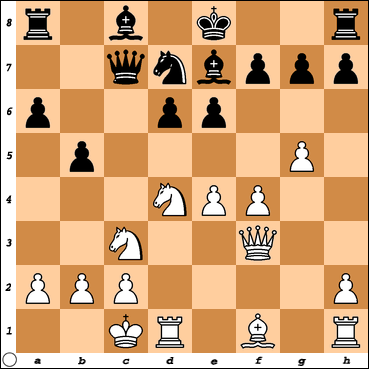
Pozycja po 12 posunieciach
-- 7. ... Ge7 8. Hf3 Hc7 9. 0-0-0 Sbd7 10. g4 b5 11. Gxf6 Sxf6 12. g5 Sd7
13. a3
13. f5 jest przedstawione w rozdziale 18.
Uzupełniający rozdział 19 zawiera 65 komentowanych partii.
----------
PS.
Super reklama ksiazki Szachowej
Bravo dla Autora J. Konikowskiego!
--
---
Post został pochwalony 0 razy
|
|
| Powrót do góry |
|
 |
| Zobacz poprzedni temat :: Zobacz następny temat |
| Autor |
Wiadomość |
wladek
Dołączył: 14 Gru 2006
Posty: 49118
Przeczytał: 0 tematów
Pomógł: 3 razy
Ostrzeżeń: 0/5
Skąd: Polaniec
|
 Wysłany: Czw 7:23, 06 Wrz 2012 Temat postu: Wysłany: Czw 7:23, 06 Wrz 2012 Temat postu: |
|
|
-
-- Technika matowania w Samomatach!
3 - P1015320
Autorzy : Dirk Borst - Harald Haverkorn - Bernhard Jacob
8984v Die Schwalbe 10/1995
858 Selbstmatt-Miniaturen Reflexm.Miniaturen 2003
1. ehrende Erwähnung
---------------------------
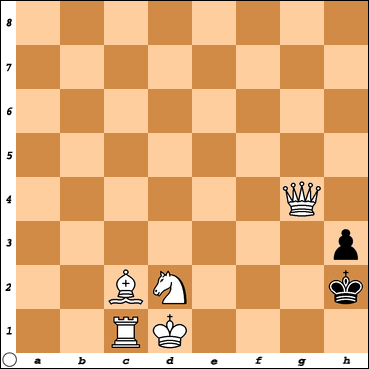
Samomacik w 11 posunieciach -- S#11
Dwa piekne rozwiazania
1. Ke1! Kh1 2. Kf2+ Kh2 3. Gd1 Kh1 4. Ge2+ Kh2 5. Kf1 Kh1 6. He4+ Kh2
7. We1 Kg3 8. Hg4+ Kh2 9. Se4 Kh1 10. Sf2+ Kh2 11. Hg2+ hxg2 - mat - diag. -- 2
1. Gd3! Kh1 2. Ke2+ Kh2 3. Kf1 Kh1 4. He4+ Kh2 5. Wc4! Kg3 6. He1+ Kh2
7. Se4 Kh1 8. Sf2+ Kh2 9. Ge2 Kg3 10. Wg4+ Kh2 11. Wg2+ hxg2 mat - diagram -3
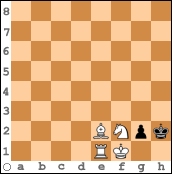 2____3 2____3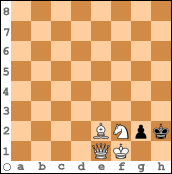
Dwie podobne siatki matowe
[link widoczny dla zalogowanych]
Poznaj technike matowania wlasnego Krola!
-
Post został pochwalony 0 razy
|
|
| Powrót do góry |
|
 |
| Zobacz poprzedni temat :: Zobacz następny temat |
| Autor |
Wiadomość |
wladek
Dołączył: 14 Gru 2006
Posty: 49118
Przeczytał: 0 tematów
Pomógł: 3 razy
Ostrzeżeń: 0/5
Skąd: Polaniec
|
 Wysłany: Wto 6:30, 11 Wrz 2012 Temat postu: Wysłany: Wto 6:30, 11 Wrz 2012 Temat postu: |
|
|
---
Kompozycja szachowa
24 - P1237447
Autor : George P. Sphicas
2040 U.S. Problem Bulletin 1990
G42 - FIDE Album 1989-1991
1. Nagroda
-----------------------
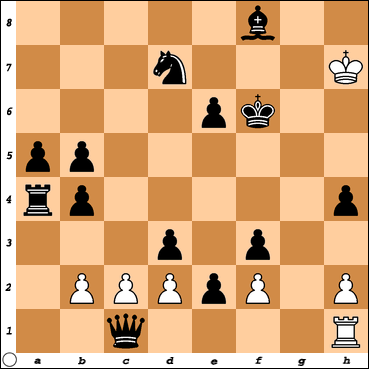
Seryjny samo pat w 42 posunieciach -- ser-s=42
Rozwiazanie
1. c4 2. cxb5 3. b6 4. b7 5. b8=D 6. Dxb4 7. Dc4 8. b4 9. bxa5
10. a6 11. a7 12. a8=L 13. Lxf3 14. Lxe2 15. f4 16. f5 17. fxe6
18. exd7 19. d8=T 20. Txd3 21. Te3 22. d4 23. d5 24. d6 25. d7
26. d8=S 27. Se6 28. Sg7 29. Kh6 30. Kh5 31. Kxh4 32. Kg4
33. h4 34. h5 35. h6 36. h7 37. h8=L 38. Th7 39. Kh5 40. Kh6
41. Lh5 42. Dh4+ Txh4= Pat --- diagram --- 2
D -- to Hetman
L -- to Goniec
T -- to Wieza
S -- to Skoczek
K -- to Krol
-----------
5 razy promocja --- Hetman - na -- Hb8!
Goniec -- na -- Ga8!
Wieza --- na -- Wd8!
Skoczek - na -- Sd8!
Goniec --- na -- Gh8!
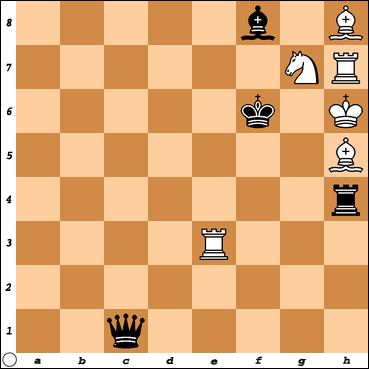
41. Gh5 - 42. Hh4+ - Wxh4= ( pat )
--
Super zadanie seryjne! Genialne...
------
Post został pochwalony 0 razy
|
|
| Powrót do góry |
|
 |
| Zobacz poprzedni temat :: Zobacz następny temat |
| Autor |
Wiadomość |
wladek
Dołączył: 14 Gru 2006
Posty: 49118
Przeczytał: 0 tematów
Pomógł: 3 razy
Ostrzeżeń: 0/5
Skąd: Polaniec
|
 Wysłany: Śro 18:54, 12 Wrz 2012 Temat postu: Wysłany: Śro 18:54, 12 Wrz 2012 Temat postu: |
|
|
-----
Pracowity bialy Skoczek!
51 - P0001874
Autor : Karl Fabel
Die Schwalbe 1941
350 FIDE Album 1914-1944/III 1975
------------
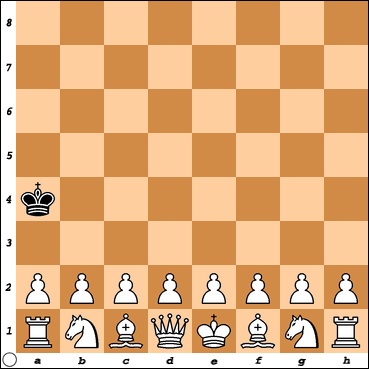
Pozycja powstala po 16 posunieciach -- bialych
Rozwiazanie
1. Sa3 b5 2. Sxb5 Sf6 3. Sxa7 Se4 4. Sxc8 Sc3
5. Sxe7 c6 6. Sxc6 Sb1 7. Sxb8 Wa3 8. Sxd7 g5
9. Sxf8 Hd6 10. Sxh7 Kd7 11. Sxg5 Wh4 12. Sxf7 Wc4
13. Sxd6 Kc6 14. Sxc4 Kb5 15. Sxa3+ Ka4 16. Sb1 --- diagram
Retro
-----------
[link widoczny dla zalogowanych]
--
Post został pochwalony 0 razy
Ostatnio zmieniony przez wladek dnia Śro 19:11, 12 Wrz 2012, w całości zmieniany 2 razy
|
|
| Powrót do góry |
|
 |
| Zobacz poprzedni temat :: Zobacz następny temat |
| Autor |
Wiadomość |
wladek
Dołączył: 14 Gru 2006
Posty: 49118
Przeczytał: 0 tematów
Pomógł: 3 razy
Ostrzeżeń: 0/5
Skąd: Polaniec
|
 Wysłany: Czw 12:26, 13 Wrz 2012 Temat postu: Wysłany: Czw 12:26, 13 Wrz 2012 Temat postu: |
|
|
1
FIDE OLYMPIC TOURNEY - 2012
(dedicated to the World Chess Olympiad 2012 in Istanbul (Turkey)
Section --- Sekcja -- Retro
PARTICIPANTS:
№1. Enzo Minevra (Italy); №2. Mario Parrinello (Italy); №3. Henryk Grudziński (Poland) ; №4. Silvio Baier (Germany); №5. Paul Rãican (Romania); №6. Diyan Kostadinov (Bulgaria); №7. Nicolas Dupont (France); №8. Stanislav Vokál (Slovakia); №9. Per Olin (Finland); №10. Antonio Garofalo (Italy); №11. Marco Bonavoglia (Italy);
№12. Vlaicu Crisan (Romania); №13. Alexandr Tyunin (Russia);
№14. Olexij Lysjanyi (Ukraine); №15. Bojan Bašić (Serbija); №16.Darko Nesek (Croatia).
The FIDE Olympic Chess Composing Tourney 2012 was an important tourney of the FIDE which was also co-ordinated with the WFCC. One of its aims was “the popularization and development of chess composition worldwide”. With this background, one could expect a large number of participating composers, with many problems of outstanding quality. However, the results of the retro section are rather disappointing. Only 16 problems took part, and many of them did not reach the level which is nowadays necessary to be included in an award. It was especially sad that no complex retros (be it orthodox or fairy) with the stipulation to release the position took part. Fortunately, there were four problems worthy to be included in the award, so that gold, silver, and bronze medals can be awarded. The prize problems are truly memorable. Before we come to these, let we make some comments about some of the other participating problems. Problem no. 2 shows optical 0-0 after actual 0-0-0 in 18.0 moves. It uses a similar constructional idea like a predecessor by Itamar Faybish (Mat Plus 2008; PDB: P1084679). This predecessor needs 19.5 moves; however, the new problem is not a new record for shortness, because the theme has already been shown in 13.5 moves (Orbit 2009; not in the PDB, see additional problem A below); and recently, I have increased the record to only 12.5 moves (Orbit 2012; not in the PDB, see additional problem B below). Problem no. 5 is too similar to a Circe Parrain Proca by Paul Raican (Die Schwalbe 2005; PDB: P1068106). Problem no. 9 has to be compared with a Chess960 problem by Per Olin (Die Schwalbe 2010; PDB: P1113793); furthermore, it contains a dual in the solution: Instead of the intended 11...Sd5 12.Bh8 Qg7, it is also possible to play 11...Qg7 [...] 16.Bh8 Sd5.
2
--------------
Autor : Silvio Baier
(Germany) FIDE Olympic Tourney 2012
1st Prize (Gold Medal)
PG in 21.0 moves (13+13)
--------------------
This “future proofgame” (cf. the special issue 250A of Die Schwalbe, August 2011) is a further development of previous achievements. The combination of two white Ceriani-Frolkin-bishops and two black Pronkin-bishops was first shown in a prize-winning proofgame by Roberto Osorio, Nicolas Dupont, and Jorge Lois in Best Problems 2007, which, however, turned out to be cooked (PDB: P1106797). Meanwhile, a corrected version (C+!) has been published in Best Problems 2012 (not in the PDB, see additional problem C below). The new problem now under consideration shows an enormous progress: Now the promotions of both white bishops and both black bishops occur on the same squares (f8/g1), which increases the harmony of the two parts of the theme; and all this takes place in only 21.0 moves, with great economy of time. There is no obtrusive promoted force in the diagram position, and the black triple pawns on the b-file can be regarded as an acceptable investment. Some might object that the predecessor already reached a great height of perfection; but, as Herbert Grasemann always insisted, in evaluating a problem, one should not just measure the difference from its predecessors, but also appreciate its total achievement; and in this case it is very great indeed.
-----------
Solution:
1. f4 h5 2. f5 h4 3. f6 h3 4. fxe7 hxg2
5. exf8=B Rh3 6. Bb4 Ra3 7. h4 a5
8. h5 axb4 9. Rh4 b3 10. Ra4 g5 11. e4 g4
12. Bc4 g3 13. Se2 g1=B 14. e5 Bc5 15. e6 Bf8
16. e7 g2 17. exf8=B g1=B 18. Bb4 Bc5 19. Ra7 Bf8
20. Kf2 c5 21. Ke3 cxb4.
--------
----------------------
3
Vlaicu Crisan
(Romania) FIDE Olympic Tourney 2012
2nd Prize (Siver Medal)
-14 & s#1 (10+4)
Proca Retractor Circe Assassin
During the last ten years, we have witnessed an astonishing phenomenon in the evolution of the Anticirce Retractors. The thematic content and the constructional finesses are very impressive, but do not appeal to many solvers (and there are also not many composers active in this field!). Furthermore, it is very hard to check Anticirce Procas for correctness. Now we see a new type of retractor problems which might develop similarly: the Circe Assassin Proca! Circe Assassin has rebirths like in regular Circe, but these rebirths come with a vengeance: If the rebirth square is occupied, the occupant is stomped into the ground by the reborn unit.
This has far-reaching consequences: When a piece of one side attacks a piece which would be reborn on the square where the opponent’s king is standing, then this king is in check! In backward play, this means that a king can easily walk into checks which the opponent then has to neutralize. This technique is also used in the problem now under consideration, which combines a long sequence of retractions with a selfmate in the forward play. Let me comment on the solution: Back 1.f5xg6(g7) e.p. g7-g5 2.Bf2xPg3(g7, -Bg7). The black pawn captured on g3 landed on the top of a black bishop at g7 which now, in the backward play, returns to existence. 2...g4-g3+ 3.Kd2-c1. White moves into check, because the bBg7 attacks the wPd4 which would be reborn on d2 (on the head of the wK). 3...Bf8-g7+ 4.Ke3xBd2(Bf8, -bQf8) Be1-d2+ 5.Kd2-e3 e2-e1=B+ 6.Kd1-d2 e3-e2+ 7.Kd2-d1 e4-e3+ 8.d3-d4 e5-e4+ 9.Kc2xPd2(d7, -bBd7) Bc8-d7+ 10.Sc7xBa6(Bc8) Bc8-a6+ 11.Kb1xBc2(Bc8, -bQc8) Bd1-c2+ 12.Kc2-b1 Be2-d1+ 13.Sa6-c7 Qb8-c8+ 14.Sc5xPa6(a7, -wSa7)+ and now White plays forward 1.Sd7+ (attacking two queens!) and forces Black to mate with 1...Kc7#. The author calls this a doubled Matrioshka theme: two “dolls” are consecutively “embedded” (passively annihilated) one in (under) another (bP -> bB -> bQ). I hope that no cooks will be found in this fine pioneer problem, and that the pioneer problems of Circe Assassin Procas will have a future at least as bright as that of the Anticirce Procas!
4
Nicolas Dupont
(France)
FIDE Olympic Tourney 2012
Honourable Mention
(Bronze Medal)
PG 30.5 (13+11) (C+)
This problem is of a type which is giving me headaches. It is a great achievement to show three Pronkin-SSS in an orthodox proofgame; BUT it is a very heavy investment to employ four black bishops and three black knights in the diagram position. I have written about this topic in the The Problemist of May 212 (p. 390), and I know that not all judges share my misgivings (cf. what Thomas Brand has written in The Problemist of November 2011, p. 254-255). But, like Martin Luther, I must say: “Here I stand, I can do no other.” In his book Chess Wizardry, John Rice quotes the views of Hermann Albrecht (p. 245): “Originality + convincing form = prize; originality with formal weaknesses = honourable mention; attractiveness without particular originality = commendation”. And since I regard obtrusive promoted force as a formal weakness, I give this original problem an honourable mention. Solution: 1.h4 a5 2.h5 a4 3.h6 a3 4.hxg7 h5 5.c4 Rh6 6.c5 Rb6 7.c6 h4 8.cxb7 c5 9.e4 Sc6 10.b8=S c4 11.Sxd7 c3 12.Se5 Bf5 13.S5f3 Bg6 14.e5 f5 15.e6 Sf6 16.g8=S c2 17.Sxe7 cxb1=B 18.Sd5 Be4 19.Sc3 Qd3 20.Sb1 0-0-0 21.e7 h3 22.e8=S h2 23.Sc7 hxg1=B 24.Sb5 Bh2 25.Sg1 Qc2 26.f3 Rd3 27.Kf2 Rb3 28.axb3 a2 29.S5a3 axb1=S 30.Ra2 Sc3 31.Sb1.
5
Stanislav Vokál
(Slovakia)
FIDE Olympic Tourney 2012
Commendation
Series Helpmate in 6 moves (10+12)
This retro problem is a nice example of the combination of forward play with backward reasoning. Most series-help-problems of this type with an en-passant-key are of the “a posteriori” kind: The key enforces later castling by the other side. In the present case, no such scheme is necessary: Retroanalysis alone can prove that White’s last move must have been g2-g4. The black pawns must have captured six white units (the bPh7 needed two captures to come around the white h-pawn), and this required the white a-pawn to promote at b8 (capturing a black unit on the way). The white b-pawn captured three more black units.
So White cannot have captured anything on his last move (because we assume that the diagram position was reached in a regular game in which White moved last, so that now Black has to make his series moves). The white King cannot have come from g7 or h7 on his last move, because there is no white unit left which could have been captured by the bRf7. And so the en-passant-key is justified, and the solution runs 1.fxg3 e.p.! 2.e3 3.exd2 4.d1=B 5.Bg4 6.Rxg6+ Sxg6#. It is not easy to combine long forward play with exact retro reasoning, and this good construction can serve as an advertisement for retros.
Judge: Bernd Graefrath, international judge
Additional problems mentioned in the award:
A:Bernd Graefrath (Orbit 2009, 2nd Commendation).
bn2kbnr/q1pp1ppp/rp1Q1p2/p7/8/NP5R/P1PPP1P1/5RK1. PG 13.5 (C+) - 1.b3 a5 2.Bb2 Ra6 3.Bf6 exf6 4.Qc1 Qe7 5.Qa3 Qe5 6.Qd6 Qxh2 7.Sa3 Qxg1 8.0-0-0 Qxf1 9.Rh3 Qxf2 10.Rf1 Qa7 11.Kd1 b6 12.Ke1 Bb7 13.Kf2 Ba8 14.Kg1.
B: Bernd Graefrath (Orbit 2012).
r3kbnr/p2ppppp/2p5/1p6/b2Q4/4BN1N/PPP1PPPP/5RK1. PG 12.5 (C+) 1.d4 Sc6 2.Be3 Sxd4 3.Qxd4 c6 4.Sd2 Qa5 5.0-0-0! b6 6.Sdf3 Qe1 7.Sh3 Qxf1 8.Kd2 Qxd1+ 9.Rxd1 Ba6 10.Ke1 Bb5 11.Kf1 Ba4 12.Kg1 b5 13.Rf1.
C: N.Dupont, J.Lois & R.Osorio (Best Problems 2007-08 (Ver.: 2012) - Dedicated to M. Richter; 1st Prize. rnb2bk1/ppp1B3/7n/1P4Pr/2P4p/P2P1K2/p1B5/RN3QNR. PG 28.0 (C+) 1.h4 e5 2.h5 e4 3.h6 e3 4.hxg7 h5 5.f4 h4 6.f5 Rh5 7.f6 Sh6 8.g8=B Bg7 9.fxg7 f5 10.a3 f4 11.Ba2 f3 12.g8=L Kf8 13.Bgb3 d5 14.c4 dxc4 15.g4 Qd3 16.exd3 f2+ 17.Ke2 cxb3 18.Kf3 bxa2 19.b4 Be6 20.b5 Bc4 21.dxc4 Kg8 22.Bd3 e2 23.Bc2 e1=B 24.d3 Bb4 25.Bg5 Bf8 26.Be7 f1=L 27.g5 Bh3 28.Qf1 Lc8.
Post został pochwalony 0 razy
|
|
| Powrót do góry |
|
 |
| Zobacz poprzedni temat :: Zobacz następny temat |
| Autor |
Wiadomość |
wladek
Dołączył: 14 Gru 2006
Posty: 49118
Przeczytał: 0 tematów
Pomógł: 3 razy
Ostrzeżeń: 0/5
Skąd: Polaniec
|
 Wysłany: Czw 12:54, 13 Wrz 2012 Temat postu: Wysłany: Czw 12:54, 13 Wrz 2012 Temat postu: |
|
|
--------
1
FIDE OLYMPIC TOURNEY - 2012
(dedicated to the World Chess Olympiad 2012 in Istanbul (Turkey)
Section --- Sekcja -- Retro
PARTICIPANTS:
№1. Enzo Minevra (Italy); №2. Mario Parrinello (Italy); №3. Henryk Grudziński (Poland) ; №4. Silvio Baier (Germany); №5. Paul Rãican (Romania); №6. Diyan Kostadinov (Bulgaria); №7. Nicolas Dupont (France); №8. Stanislav Vokál (Slovakia); №9. Per Olin (Finland); №10. Antonio Garofalo (Italy); №11. Marco Bonavoglia (Italy);
№12. Vlaicu Crisan (Romania); №13. Alexandr Tyunin (Russia);
№14. Olexij Lysjanyi (Ukraine); №15. Bojan Bašić (Serbija); №16.Darko Nesek (Croatia).
The FIDE Olympic Chess Composing Tourney 2012 was an important tourney of the FIDE which was also co-ordinated with the WFCC. One of its aims was “the popularization and development of chess composition worldwide”. With this background, one could expect a large number of participating composers, with many problems of outstanding quality. However, the results of the retro section are rather disappointing. Only 16 problems took part, and many of them did not reach the level which is nowadays necessary to be included in an award. It was especially sad that no complex retros (be it orthodox or fairy) with the stipulation to release the position took part. Fortunately, there were four problems worthy to be included in the award, so that gold, silver, and bronze medals can be awarded. The prize problems are truly memorable. Before we come to these, let we make some comments about some of the other participating problems. Problem no. 2 shows optical 0-0 after actual 0-0-0 in 18.0 moves. It uses a similar constructional idea like a predecessor by Itamar Faybish (Mat Plus 2008; PDB: P1084679). This predecessor needs 19.5 moves; however, the new problem is not a new record for shortness, because the theme has already been shown in 13.5 moves (Orbit 2009; not in the PDB, see additional problem A below); and recently, I have increased the record to only 12.5 moves (Orbit 2012; not in the PDB, see additional problem B below). Problem no. 5 is too similar to a Circe Parrain Proca by Paul Raican (Die Schwalbe 2005; PDB: P1068106). Problem no. 9 has to be compared with a Chess960 problem by Per Olin (Die Schwalbe 2010; PDB: P1113793); furthermore, it contains a dual in the solution: Instead of the intended 11...Sd5 12.Bh8 Qg7, it is also possible to play 11...Qg7 [...] 16.Bh8 Sd5.
2
--------------
Autor : Silvio Baier
(Germany) FIDE Olympic Tourney 2012
1st Prize (Gold Medal)
--------------------
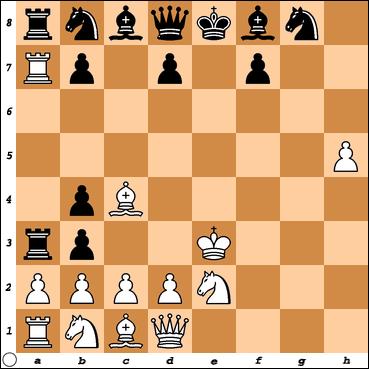
Pozycja powstala po 21 posunieciach czarnych
PG in 21.0 moves (13+13)
--------------------
This “future proofgame” (cf. the special issue 250A of Die Schwalbe, August 2011) is a further development of previous achievements. The combination of two white Ceriani-Frolkin-bishops and two black Pronkin-bishops was first shown in a prize-winning proofgame by Roberto Osorio, Nicolas Dupont, and Jorge Lois in Best Problems 2007, which, however, turned out to be cooked (PDB: P1106797). Meanwhile, a corrected version (C+!) has been published in Best Problems 2012 (not in the PDB, see additional problem C below). The new problem now under consideration shows an enormous progress: Now the promotions of both white bishops and both black bishops occur on the same squares (f8/g1), which increases the harmony of the two parts of the theme; and all this takes place in only 21.0 moves, with great economy of time. There is no obtrusive promoted force in the diagram position, and the black triple pawns on the b-file can be regarded as an acceptable investment. Some might object that the predecessor already reached a great height of perfection; but, as Herbert Grasemann always insisted, in evaluating a problem, one should not just measure the difference from its predecessors, but also appreciate its total achievement; and in this case it is very great indeed.
--------------
Autor : Silvio Baier
(Germany) FIDE Olympic Tourney 2012
1st Prize (Gold Medal)
--------------

Pozycja powstala po 21 posunieciach czarnych
PG in 21.0 moves (13+13)
-----------
Solution -- Rozwiazanie
1. f4 h5 2. f5 h4 3. f6 h3 4. fxe7 hxg2
5. exf8=G - Wh3 6. Gb4 Wa3 7. h4 a5
8. h5 axb4 9. Wh4 b3 10. Wa4 g5 11. e4 g4
12. Gc4 g3 13. Se2 g1=G - 14. e5 Gc5 15. e6 Gf8
16. e7 g2 17. exf8=G -- g1=G -- 18. Gb4 Gc5 19. Wa7 Gf8
20. Kf2 c5 21. Ke3 cxb4. --- Diagram -- u gory
[link widoczny dla zalogowanych]
Dwie promocje bialych Goncow na polu _f8
Dwie promocje czarnych Goncow na polu _g1
---
---
Post został pochwalony 0 razy
Ostatnio zmieniony przez wladek dnia Czw 13:12, 13 Wrz 2012, w całości zmieniany 5 razy
|
|
| Powrót do góry |
|
 |
| Zobacz poprzedni temat :: Zobacz następny temat |
| Autor |
Wiadomość |
wladek
Dołączył: 14 Gru 2006
Posty: 49118
Przeczytał: 0 tematów
Pomógł: 3 razy
Ostrzeżeń: 0/5
Skąd: Polaniec
|
 Wysłany: Czw 13:17, 13 Wrz 2012 Temat postu: Wysłany: Czw 13:17, 13 Wrz 2012 Temat postu: |
|
|
--------
1
FIDE OLYMPIC TOURNEY - 2012
(dedicated to the World Chess Olympiad 2012 in Istanbul (Turkey)
Section --- Sekcja -- Retro
-------------
Autor : Silvio Baier
(Germany) FIDE Olympic Tourney 2012
1st Prize (Gold Medal)
--------------------

Pozycja powstala po 21 posunieciach czarnych
PG in 21.0 moves (13+13)
--------------------
This “future proofgame” (cf. the special issue 250A of Die Schwalbe, August 2011) is a further development of previous achievements. The combination of two white Ceriani-Frolkin-bishops and two black Pronkin-bishops was first shown in a prize-winning proofgame by Roberto Osorio, Nicolas Dupont, and Jorge Lois in Best Problems 2007, which, however, turned out to be cooked (PDB: P1106797). Meanwhile, a corrected version (C+!) has been published in Best Problems 2012 (not in the PDB, see additional problem C below). The new problem now under consideration shows an enormous progress: Now the promotions of both white bishops and both black bishops occur on the same squares (f8/g1), which increases the harmony of the two parts of the theme; and all this takes place in only 21.0 moves, with great economy of time. There is no obtrusive promoted force in the diagram position, and the black triple pawns on the b-file can be regarded as an acceptable investment. Some might object that the predecessor already reached a great height of perfection; but, as Herbert Grasemann always insisted, in evaluating a problem, one should not just measure the difference from its predecessors, but also appreciate its total achievement; and in this case it is very great indeed.
--------------
Autor : Silvio Baier
(Germany) FIDE Olympic Tourney 2012
1st Prize (Gold Medal)
--------------

Pozycja powstala po 21 posunieciach czarnych
PG in 21.0 moves (13+13)
-----------
Solution -- Rozwiazanie
1. f4 h5 2. f5 h4 3. f6 h3 4. fxe7 hxg2
5. exf8=G - Wh3 6. Gb4 Wa3 7. h4 a5
8. h5 axb4 9. Wh4 b3 10. Wa4 g5 11. e4 g4
12. Gc4 g3 13. Se2 g1=G - 14. e5 Gc5 15. e6 Gf8
16. e7 g2 17. exf8=G -- g1=G -- 18. Gb4 Gc5 19. Wa7 Gf8
20. Kf2 c5 21. Ke3 cxb4. --- Diagram -- u gory
[link widoczny dla zalogowanych]
Dwie promocje bialych Goncow na polu _f8
Dwie promocje czarnych Goncow na polu _g1
---
---
Post został pochwalony 0 razy
|
|
| Powrót do góry |
|
 |
| Zobacz poprzedni temat :: Zobacz następny temat |
| Autor |
Wiadomość |
wladek
Dołączył: 14 Gru 2006
Posty: 49118
Przeczytał: 0 tematów
Pomógł: 3 razy
Ostrzeżeń: 0/5
Skąd: Polaniec
|
 Wysłany: Czw 14:24, 13 Wrz 2012 Temat postu: Wysłany: Czw 14:24, 13 Wrz 2012 Temat postu: |
|
|
--------
1
FIDE OLYMPIC TOURNEY - 2012
(dedicated to the World Chess Olympiad 2012 in Istanbul (Turkey)
Section --- Sekcja -- Retro
Autor : Silvio Baier
(Germany) FIDE Olympic Tourney 2012
1st Prize (Gold Medal)
--------------

Pozycja powstala po 21 posunieciach czarnych
PG in 21.0 moves (13+13)
-----------
Solution -- Rozwiazanie
1. f4 h5 2. f5 h4 3. f6 h3 4. fxe7 hxg2
5. exf8=G - Wh3 6. Gb4 Wa3 7. h4 a5
8. h5 axb4 9. Wh4 b3 10. Wa4 g5 11. e4 g4
12. Gc4 g3 13. Se2 g1=G - 14. e5 Gc5 15. e6 Gf8
16. e7 g2 17. exf8=G -- g1=G -- 18. Gb4 Gc5 19. Wa7 Gf8
20. Kf2 c5 21. Ke3 cxb4. --- Diagram -- u gory
[link widoczny dla zalogowanych]
Dwie promocje bialych Goncow na polu _f8
Dwie promocje czarnych Goncow na polu _g1
---
Post został pochwalony 0 razy
|
|
| Powrót do góry |
|
 |
| Zobacz poprzedni temat :: Zobacz następny temat |
| Autor |
Wiadomość |
wladek
Dołączył: 14 Gru 2006
Posty: 49118
Przeczytał: 0 tematów
Pomógł: 3 razy
Ostrzeżeń: 0/5
Skąd: Polaniec
|
 Wysłany: Sob 8:26, 15 Wrz 2012 Temat postu: Wysłany: Sob 8:26, 15 Wrz 2012 Temat postu: |
|
|
----
Siatki matowe --- na forum Poznania.
[link widoczny dla zalogowanych]
--
Kompozytor szachowy _ Godfrey Heathcote
162 - P1039968
Godfrey Heathcote
Bristol Mercury 1891 , 1. Nagroda
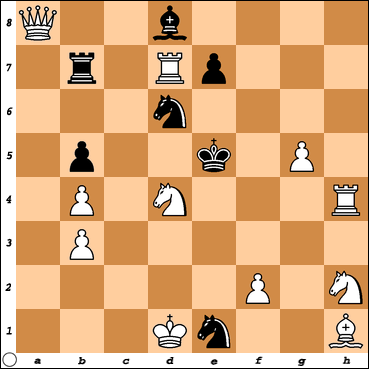
mat w 2 posunieciach > #2 -- 1. Gh1 - Ge4! -- tempo
162 - P1039968
Godfrey Heathcote
Bristol Mercury 1891
1. Preis
Rozwiazanie:
1. Ge4! ---- tempo
1. ... Gc7 ------- 2. Hh8#
1. ... Wa7 ------ 2. Hd5#
1. ... e6 -------- 2. Sc6#
1. ... Sc8 ------- 2. Wd5#
1. ... Sxe4 ----- 2. f4#
1. ... Kxd4 ---- 2. Ha1#
1. ... Sd3 ----- 2. Shf3#
-------------
Autor: A. van der Ven, 1925
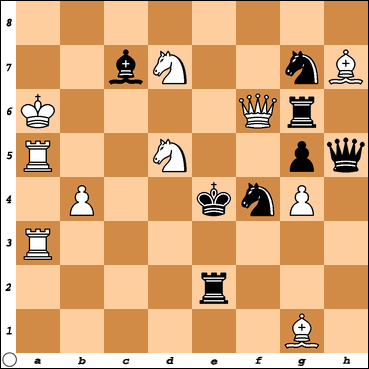
Mat w 2 posunieciach _ #2 -- --- 1. Gh7- Gg8!
Rozwiazanie
1. Gg8! -- grozi -- [2. Sc5#]
1. ... Gd6 ---- 2. Hd4#
1. ... Gb6 ---- 2. He5#
1. ... Sge6 --- 2. Hf5#
1. ... Wxf6+ - 2. S5xf6#
1. ... Sfe6 --- 2. Hf3#
1. ... Sd3 --- 2. Sc3#
1. ... Wc2 -- 2. We3#
Bialy Hetman jest czterokrotnie uwalniany od wiazania ,
by dac mata __ 2. Hd4 , 2. He5 , 2. Hf5 , 2. Hf3 mat
Zadanie moze sie podobac...7 siatek matowych ,
konstrukcja poprawna.
--------
Godfrey Heathcote
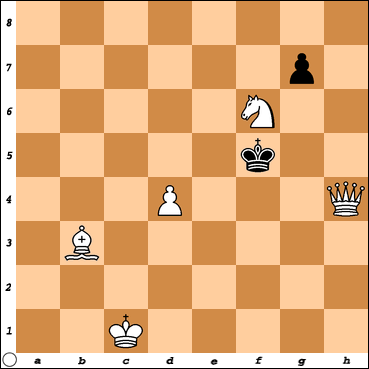
mat w 3 posunieciach -- #3 ----- 5 siatek matowych
Rozwiazanie
1. Kd2! --- tempo
1. ... gxf6 -- 2. Hg3 tempo
2. ... Ke4 -- 3. Hg4#
1. ... g6 --- 2. Gf7 tempo
2. ... g5 -- 3. Hf2#
1. ... g5 ---- 2. Hh5 tempo
2. ... Kxf6 -- 3. Hf7#
2. ... Kf4 ---- 3. Hg4#
1. ... Kg6 --- 2. Sg8 [3. Se7#]
2. ... Kf5 --- 3. Se7#
5 siatek matowych w trzychodowce - miniaturze ,
to wielkie osiagniecie kompozytora
------
Post został pochwalony 0 razy
|
|
| Powrót do góry |
|
 |
| Zobacz poprzedni temat :: Zobacz następny temat |
| Autor |
Wiadomość |
wladek
Dołączył: 14 Gru 2006
Posty: 49118
Przeczytał: 0 tematów
Pomógł: 3 razy
Ostrzeżeń: 0/5
Skąd: Polaniec
|
 Wysłany: Pią 7:57, 21 Wrz 2012 Temat postu: Wysłany: Pią 7:57, 21 Wrz 2012 Temat postu: |
|
|
---------
Metoda uczenia -- 5-7 latkow
Rozwiąż, nim zaczniesz czytać Szacharnię
(zaczyna ten, kto jest na dole)
polecam młodzieży.
------------------
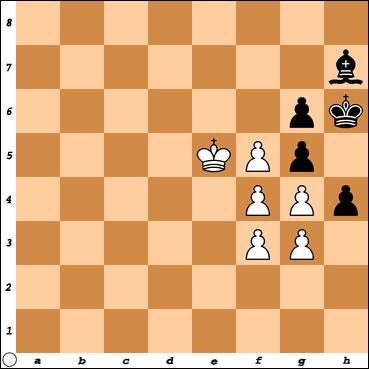 - -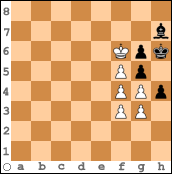
Biale matuja w 4 posunieciach -- #4 ----- po pierwszym posunieciu --- 1. Kf6
Rozwiazanie -- 1. Ke5! - Kf6!! --- atakuje trzy wazne pola -- g7-g6 -g5
1. Ke5 - Kf6! -- grozi -- 2. fxg5 - mat
1. Ke5 - Kf6! -- gxf4 - 2. g5+ Kh5 - 3. g4 - mat --- diagram -- 2
1. Ke5 - Kf6! - Gg8 - 2. f5xg6 - g5xf4
3. g5+ - Kh5 -- 4. g4 - mat --- diagram -- 3
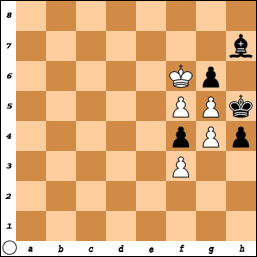 _3 _3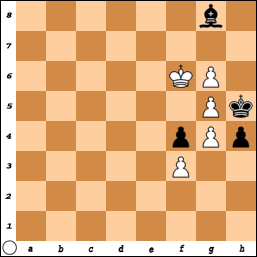
---- diagram -- 2 ---------------- diagram 3. -- 2. fxg6 - gxf4 3. g5 - Kh5 - 4. g4- mat
------------
Czarne przy najlepszej obronie -- 1. ... Gg8 zostaja zamatowane w 4 ruchu
przez biale, przy innych posunieciach mat bedzie szybszy -- widac to na diagramach.
Takie rozwiazania trzeba podawac na diagramach szachowych , gdyz dzieci w tym
wieku ( 5-7 lat ) maja trudnosci zapamietac pozycje matowe.
Do rozwiazywania takich zadan polecam -- Szachy Diagramowe -- z ktorych czesto
korzysta szescio-krotny Mistrz Swiata Piotr Murdzia
---
uzupelnienie
Ustawiony maly diagram -- pozycja po -- 1. Kf6!
-
-----------
Poznaj zadania -- S. Loyda!
Autor : Samuel Loyd - 1856
-----------------
 1___2 1___2
Biale matuja w 3 posunieciach -- #3 ---- --- wyzej siatka matowa
Zadanie -- 15-letniego -- S. LOYDA
------------
Program „Szachy w szkole” zyskał poparcie Parlamentu Europejskiego!
Niezmiernie miło nam poinformować, że Oświadczenie Pisemne 50/2011 dotyczące wprowadzenia programu "Szachy w szkole" w szkołach w Unii Europejskiej zostało podpisane przez 415 posłów do Parlamentu Europejskiego (potrzebne było 378 podpisów, czyli 50% + 1 z całkowitej liczby 754 Europosłów). Po zakończonej sesji Parlamentu Europejskiego, Europosłowie gratulowali prezydentowi Europejskiej Unii Szachowej, podkreślając, że zatwierdzenie programu jest wielkim sukcesem - zazwyczaj tylko 10-15% oświadczeń zyskuje wymaganą liczbę głosów.
Wszystkie działania promujące program "Szachy w szkole" odbywały się pod patronatem honorowym prof. Jerzego Buzka, poprzedniego prezydenta Parlamentu Europejskiego oraz Slavy Bineva, posła do Parlamentu Europejskiego z Bułgarii, który wspierał projekt i wprowadzenie Oświadczenia Pisemnego 50/2011.
Polski Związek Szachowy włączył się w kampanię promująca "Szachy w szkole", nawiązując kontakt ze wszystkimi polskimi Europosłami. Warto nadmienić, że polscy Europarlamentarzyści niemal w komplecie podpisali się pod wprowadzeniem programu "Szachy w szkole". Dziękujemy!
Informacja na stronie Europejskiej Unii Szachowej
------------------------
96 - P1054045
Autor : Waldemar Tura
Schach 1973 -- FIDE Album (1971-1973)
-------

Mat w 2 posunieciach --
Rozwiązanie
1. Scb6! -- [2. Sc5, Sxb2#]
1. ... Gxb6 -- 2. Sxb2#
1. ... Wxb6 -- 2. Sc5#
1. ... Gxa4 -- 2. Gf5#
1. ... Sxa4 -- 2. Gc4#
1. ... Sc4 ---- 2. Gxc4 #
--
Post został pochwalony 0 razy
|
|
| Powrót do góry |
|
 |
| Zobacz poprzedni temat :: Zobacz następny temat |
| Autor |
Wiadomość |
wladek
Dołączył: 14 Gru 2006
Posty: 49118
Przeczytał: 0 tematów
Pomógł: 3 razy
Ostrzeżeń: 0/5
Skąd: Polaniec
|
 Wysłany: Pon 22:30, 24 Wrz 2012 Temat postu: Wysłany: Pon 22:30, 24 Wrz 2012 Temat postu: |
|
|
---
Poznaj samomaty - jak Garii Kasparow -- poznaje.
Autor : Andrej Selivanov
FIDE Olimpic Turniej- 2012
Gold Medal
-----------
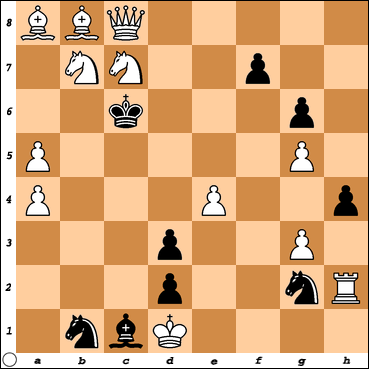
Samomacik w 5 posunieciach -- S#5 -- -- 1. e5!
Cztery piekne siatki matowe
Rozwiazanie -- na [link widoczny dla zalogowanych]
----
Post został pochwalony 0 razy
|
|
| Powrót do góry |
|
 |
| Zobacz poprzedni temat :: Zobacz następny temat |
| Autor |
Wiadomość |
wladek
Dołączył: 14 Gru 2006
Posty: 49118
Przeczytał: 0 tematów
Pomógł: 3 razy
Ostrzeżeń: 0/5
Skąd: Polaniec
|
 Wysłany: Nie 8:36, 30 Wrz 2012 Temat postu: Re: Album FIDE Wysłany: Nie 8:36, 30 Wrz 2012 Temat postu: Re: Album FIDE |
|
|
---
Album FIDE
Zadanie treningowe..
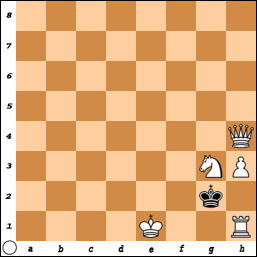
Mat w 2 posunieciach -- #2 -- 5 rozwiazan
1. Hg5! -- Kf3 --- 2. 0-0 ( mala roszada ) -- mat
--------------
1. He4+ --- Kxg3 ---- 2. Hg4 --- mat
---------------
1. Hh5 ----= Kxg3 ---- 2. Hg4 -- mat
--------------
1. Hf6 ------ Kxg3 ----- 2. Hf2 --- mat
--------------
1. Hd4 ----- Kf3 ------- 2. Hf2 ---- mat
--------
Poznawanie na pamiec pol szachownicy....---
-- Sprawdz sie w koncowkach taktycznych
Autor : Furio Slepjan -- 1981
----
 - -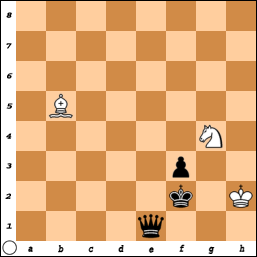 2 2
----------------------- Diagram --- 1 ---- -- ---- 5. Sg4! - mat --diagram -- 2
Biale zaczynaja i wygrywaja -- ( + ) --- Pozycja finalowa - 5. Sg4 - mat
Rozwiazanie
1. Hf1+!! - Kxf1
2. Gb5+ -- Hc4
3. Sxc4!! - fxe1=H
4. Se3+ -- Kf2
5. Sg4! - mat --- diagram -- 2
--------
Post został pochwalony 0 razy
|
|
| Powrót do góry |
|
 |
| Zobacz poprzedni temat :: Zobacz następny temat |
| Autor |
Wiadomość |
wladek
Dołączył: 14 Gru 2006
Posty: 49118
Przeczytał: 0 tematów
Pomógł: 3 razy
Ostrzeżeń: 0/5
Skąd: Polaniec
|
 Wysłany: Nie 19:04, 30 Wrz 2012 Temat postu: Wysłany: Nie 19:04, 30 Wrz 2012 Temat postu: |
|
|
------
Urok kompozycji szachowej!
Technika matowania...
Autor : C. Mansfield --- arcymistrz kompozycji szachowej
-------------------
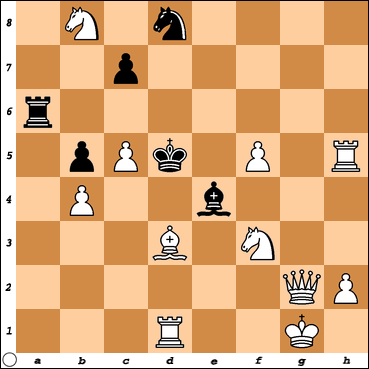 2 2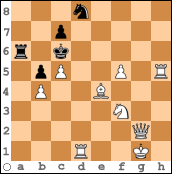
Matowanie na diagramie -- #2 -------- ---------- 1. Sc6! -- Kxc6 -- 2. Gxe4 - mat
Rozwiazanie
1. Sc6! -- grozi -- 2. Se7 - mat
1. Sc6 --- Wxc6 -- 2. Ha2! - mat
1. Sc6 --- Sxc6 --- 2. Hg8 - mat
1. Sc6 --- Gxf3 --- 2. Hxf3 - mat
------------------------
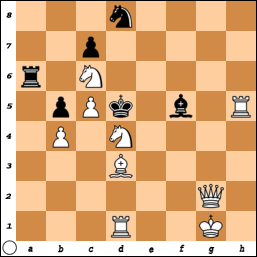 _4 _4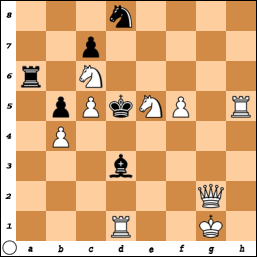
Dwie pary siatek matowych --- ---- ze zwiazaniem czarnego Gonca
1. Sc6! -- Gxf5 - 2. Sfd4 - mat ---- ---- 1. Sc6! -- Gxd3 - 2. Sfe5 - mat
---------
Post został pochwalony 0 razy
|
|
| Powrót do góry |
|
 |
|
|
Nie możesz pisać nowych tematów
Nie możesz odpowiadać w tematach
Nie możesz zmieniać swoich postów
Nie możesz usuwać swoich postów
Nie możesz głosować w ankietach
|
fora.pl - załóż własne forum dyskusyjne za darmo
Powered by phpBB © 2001, 2005 phpBB Group
|




 _3
_3
 1___2
1___2







 2____3
2____3







 -
-
 _3
_3


 -
-
 2
2
 _4
_4